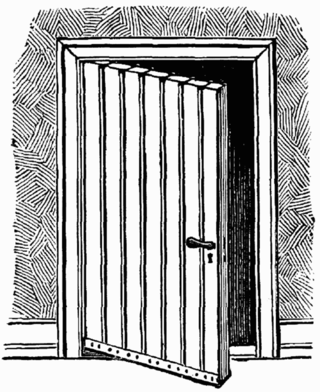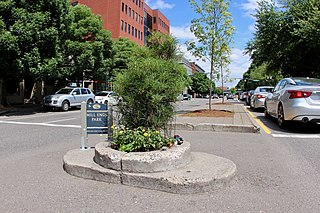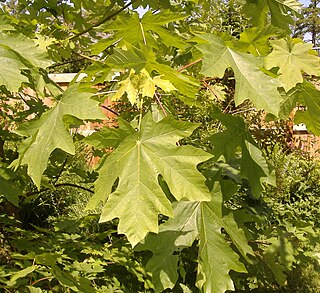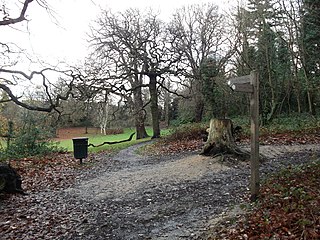
A door is a hinged or otherwise movable barrier that allows ingress (entry) into and egress (exit) from an enclosure. The created opening in the wall is a doorway or portal. A door's essential and primary purpose is to provide security by controlling access to the doorway (portal). Conventionally, it is a panel that fits into the doorway of a building, room, or vehicle. Doors are generally made of a material suited to the door's task. They are commonly attached by hinges, but can move by other means, such as slides or counterbalancing.
The International Rose Test Garden is a rose garden in Washington Park in Portland, Oregon, United States. There are over 10,000 rose bushes of approximately 650 varieties. The roses bloom from April through October with the peak coming in June, depending on the weather. New rose cultivars are continually sent to the garden from many parts of the world and are evaluated on several characteristics, including disease resistance, bloom formation, color, and fragrance. It is the oldest continuously operating public rose test garden in the United States and exemplifies Portland's nickname, "City of Roses". The garden draws an estimated 700,000 visitors annually.

Woodland Park Zoo is a wildlife conservation organization and zoological garden located in the Phinney Ridge neighborhood of Seattle, Washington, United States. The zoo is the recipient of over 65 awards across multiple categories. The zoo has around 900 animals from 250 species and the zoo has over 1 million visitors a year.

Mill Ends Park is an extremely small urban park, consisting of one tree, located in the median strip of SW Naito Parkway next to Tom McCall Waterfront Park along the Willamette River near SW Taylor Street in the downtown core of Portland, Oregon, United States. The park is a small circle 2 ft (0.61 m) across, with a total area of 452 sq in (0.292 m2). It is the smallest park in the world, according to the Guinness Book of Records, which first granted it this recognition in 1971, though this title may be soon given to a 2022 park in Talent, Oregon, which is 78 sq in (500 cm2) smaller.

Acer macrophyllum, the bigleaf maple or Oregon maple, is a large deciduous tree in the genus Acer. It is native to western North America. In addition to uses by animals, it is of some culinary and woodworking interest.

The Fitzroy Gardens are 26 hectares located on the southeastern edge of the Melbourne central business district in East Melbourne, Victoria, Australia. The gardens are bounded by Clarendon Street, Albert Street, Lansdowne Street, and Wellington Parade with the Treasury Gardens across Lansdowne street to the west.

The Minneapolis Sculpture Garden is an 11-acre (4.5 ha) park in Minneapolis, Minnesota, in the United States. It is located near the Walker Art Center, which operates it in coordination with the Minneapolis Park and Recreation Board. It reopened June 10, 2017, after a reconstruction that resulted with the Walker and Sculpture Garden being unified as one 19-acre campus. It is one of the largest urban sculpture gardens in the country, with 40 permanent art installations and several other temporary pieces that are moved in and out periodically.

Euonymus europaeus, the spindle, European spindle, or common spindle, is a species of flowering plant in the family Celastraceae, native to much of Europe, where it inhabits the edges of forest, hedges and gentle slopes, tending to thrive on nutrient-rich, chalky and salt-poor soils. It is a deciduous shrub or small tree.
The London Borough of Bexley owns and maintains over 100 parks and open spaces within its boundaries, with a total of 638 hectares. They include small gardens, river and woodland areas, and large parks with many sporting and other facilities.

Stanley Park is a non-profit privately owned park including an arboretum and botanical garden, located in Westfield, Massachusetts. It is open to the public daily without charge from May to November. Although the park is closed during the winter, people can still enter the park at their own risk. The duck pond area is monitored 24/7 with three security cameras, which are accessible on the park's websites.

Beaulieu Heights 16 acres (6.5 ha) is an area of ancient woodland between South Norwood and Upper Norwood in the London Borough of Croydon, London. It is located between South Norwood Hill and Auckland Road with Auckland Rise to the north and Tummonds Gardens to the south. There are pedestrian entrances from South Norwood Hill and Auckland Rise, and a pond. The name is pronounced as if spelled "Beulah" like the nearby Beulah Hill, and not like the French word or the town of Beaulieu, Hampshire.

Noble Woods Park is a wooded city park in Hillsboro, Oregon, United States. Located on approximately 40 acres (160,000 m2) along Rock Creek, the nature park with wetlands and forests is situated between West Baseline Road on the north and Southwest Borwick Road to the south near the Orenco neighborhood. The city acquired the land for the park in 1992 and opened the park in the eastern section of the city in 1998. Noble Woods has two entrances, a picnic area, and hiking trails.

Wayford is a village and civil parish on the River Axe, 3 miles (5 km) south-west of Crewkerne, in the South Somerset district of Somerset, England.

The Alvin T. Smith House is a two-story home on Elm Street in Forest Grove, Oregon, United States. Completed in 1856, it is the second oldest building in the city and was added to the National Register of Historic Places in 1974. A Greek Revival style house, it was built by pioneer Alvin T. Smith beginning in 1854.

Cascadia State Park is a state park in the U.S. state of Oregon near Sweet Home along the South Santiam River at Cascadia. The park includes a day use area, campsites, hiking trails and 150 foot Lower Soda Creek Falls.

Wayford Manor House is a country house with a garden in Britain, situated in Wayford, Somerset, England. It has been designated a Grade I listed building.

The Fairy Doors of Ann Arbor are a series of small doors that are a type of installation art found in the city of Ann Arbor in the U.S. state of Michigan. The first one appeared in the baseboards of the home of Jonathan and Kathleen Wright in 1993. Subsequently, several others were discovered in their home: in the fireplace surround and two in the kitchen. On April 7, 2005, the first was seen in public on the exterior of Sweetwaters Coffee and Tea. Since then, ten more have shown up around Ann Arbor, and seven of the original "public" doors still exist.

Mill River Park is a 12-acre urban park located in downtown Stamford, Connecticut. The park, which separates Downtown from the West Side, features a restored section of the Mill River, extensive landscaping, and various recreational amenities. It is the result of a long-term redevelopment project aimed at reclaiming green space and improving the ecological health of the area. The park's development began in 1998 with a preliminary study by Sasaki Associates, resulting in the Mill River Corridor Plan to reclaim 26 acres of green space in downtown Stamford. In 2000, the U.S. Army Corps of Engineers endorsed the removal of the Mill River Dam to restore wetland habitat and improve public access to the river. The Mill River Park Collaborative, a non-profit organization, was founded in 2003 to lead the creation, growth, and operations of the new park.

Nelson Meade County Farm Park is a 141-acre public park in eastern Ann Arbor, Michigan owned by Washtenaw County and operated by the county's Parks and Recreation Commission. Consisting of a mix of woodlands, fields, and gardens, the park is home to a wide variety of flora and fauna and is a popular local destination for gardening, hiking, jogging, and biking. The park has been county land since 1836, although for the majority of the nineteenth and twentieth centuries it was used as the county's poorhouse and then as its infirmary. In 1972, the site began transitioning to parkland with the creation of community gardens, and over the next couple decades various trails and a perennial garden were created. Since 2000, the park has experienced significant ecological restoration efforts, including the removal of invasive plants, prairie restoration, and the creation of a wet meadow during the restoration of Malletts Creek.

The land comprising New York City holds approximately 5.2 million trees and 168 different tree species, as of 2020. The New York City government, alongside an assortment of environmental organizations, actively work to plant and maintain the trees. As of 2020, New York City held 44,509 acres of urban tree canopy with 24% of its land covered in trees.




















